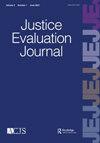Absenteeism Interventions: An Approach for Common Definitions in Statewide Program Evaluations
IF 0.7
Q3 CRIMINOLOGY & PENOLOGY
引用次数: 9
Abstract
Abstract Chronic absenteeism is related to poor academic performance, delinquency, and other high-risk behaviors. Although research has found some promising interventions to reduce absenteeism, the literature lacks clarity on operationalizing absenteeism and when programs should intervene with youth who have varying absenteeism patterns. Using the Response to Intervention (RtI) framework to classify youth into tiers based on their degree of absenteeism, the present study evaluated 12 absenteeism programs, across 137 schools, with a sample of 1,606 youth as part of a statewide evaluation in which programs provided attendance data using a common measurement system. The findings indicated that youth with the highest rates of absenteeism (Tier 3) showed significant improvement in attendance during intervention, whereas youth with fewer absences (Tiers 1A, 1B, and 2) did not significantly improve attendance. Using a mixed repeated measures analysis to compare attendance prior to the program to attendance while in the program, results revealed that tier classification and school explained change in attendance for both excused and unexcused absences. Using common measurement for absenteeism and tier classifications is a useful framework for comparing attendance patterns and program success across programs within different schools, school districts, and states whose measurement of attendance may vary.缺勤干预:在全州范围内的项目评估的共同定义的方法
长期旷工与学习成绩差、犯罪和其他高危行为有关。虽然研究发现了一些有希望的干预措施来减少缺勤,但文献缺乏对缺勤的操作性以及何时应该对具有不同缺勤模式的青少年进行干预的明确说明。本研究采用干预响应(RtI)框架,根据青少年的缺勤程度对其进行分级,评估了137所学校的12个缺勤项目,样本为1606名青少年,作为全州评估的一部分,其中项目使用通用测量系统提供出勤数据。研究结果表明,在干预期间,缺勤率最高的青少年(3级)的出勤率显著提高,而缺勤率较低的青少年(1A、1B和2级)的出勤率没有显著提高。使用混合重复测量分析来比较项目前和项目期间的出勤情况,结果显示,等级分类和学校解释了请假缺勤和未请假缺勤的出勤变化。使用常见的缺勤测量方法和等级分类是比较不同学校、学区和州的出勤模式和项目成功的有用框架,这些学校、学区和州的出勤测量方法可能有所不同。
本文章由计算机程序翻译,如有差异,请以英文原文为准。
求助全文
约1分钟内获得全文
求助全文

 求助内容:
求助内容: 应助结果提醒方式:
应助结果提醒方式:


